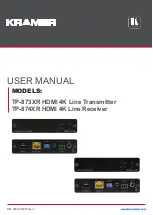
7
Pulse / toggle mode transmitters
This option ONLY applies to transmitters, NOT keyfobs and detectors.
➢
Dipswitch 2 set to ON is toggle. Dipswitch 2 set to OFF is pulse.
In toggle mode, the position of the relay contact will always change (and remain so) after pressing the button on
the transmitter. In pulse mode the relay contact is activated for approximately 2 seconds and switches back again.
The position of dipswitch 2 has no purpose for a PIR detector, smoke detector, gas detector, vibration sensor and
water detectors. When activated, these will always pulse the output for approximately 2 seconds.
The position of dipswitch 2 has no purpose for a keyfob and magnetic contact.
When activated, the relay contact will always act as a toggle output.
PIR detector battery save mode
On the AT-304 PG2 (PowerG) model receiver with pcb revision 1.2 it is advised to set lever 6 of dipswitch 1-8 to ON
when using PowerG motion sensors (PIR detectors). Dipswitch 6
turns on the “battery save mode”
for PowerG
motion sensors (PIR detectors). If this mode is set to ON and a PowerG PIR detector transmits an alarm, the AT-304
will send back a message to the PowerG motion sensor
to “fall asleep” for 2 minutes
and thus will not detect and
transmit a new alarm. Only after 2 minutes if the PowerG motion sensor detects movement again it will transmit
again to the AT-304 receiver. This limits the amount of alarm transmission and extends the lifetime of the battery
in the PowerG motion sensor.
The AT-304 receiver with pcb revision 1.3. and higher the pcb is equipped with an extra "Arm" input, this input can
be connected to an output of an intrusion panel that indicates the status (ARMED/DISARMED) of the connected
system. When using the AT-304 PG2, the "ARM" input must be connected otherwise the PowerG motion sensors
will not transmit an alarm if motion is detected.
Note: Dipswitch 6 "battery save" mode does NOT work on pcb revision 1.3 print with the AT-304 PG2 (PowerG)!
Note: It is crucial to connect the "ARM" input to the AT-304 PG2 print revision 1.3, otherwise PowerG
motion sensors will not wake up and cannot trigger an alarm!
When using the AT-304 PowerCode model receiver with PowerCode motion sensors (PIR detectors) dipswitch 6 on
dipswitch 1-8 does not have to be set to ON to activate the battery save mode. PowerCode motion sensors already
have a built-in battery save mode that ensures that the motion sensor will go to sleep after detection for 2
minutes. Only after 2 minutes the motion sensor can detect new motion and send it to the AT-304. This limits the
amount of alarm transmissions sent by the motion sensor thus extending the battery lifetime.
Note: The AT-304 PowerG receiver will communicate with all enrolled PowerG devices during start-up. This start-
up procedure can take up to 1 minute within which a PowerG device may not yet be connected to the AT-304
and thus will not activate the relay output on the receiver.


























